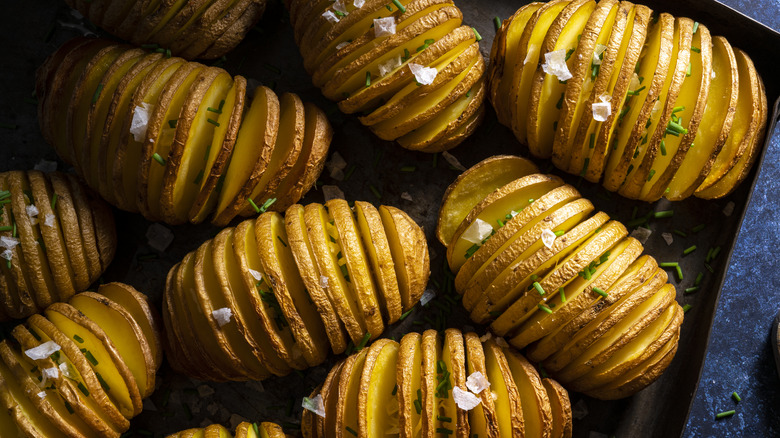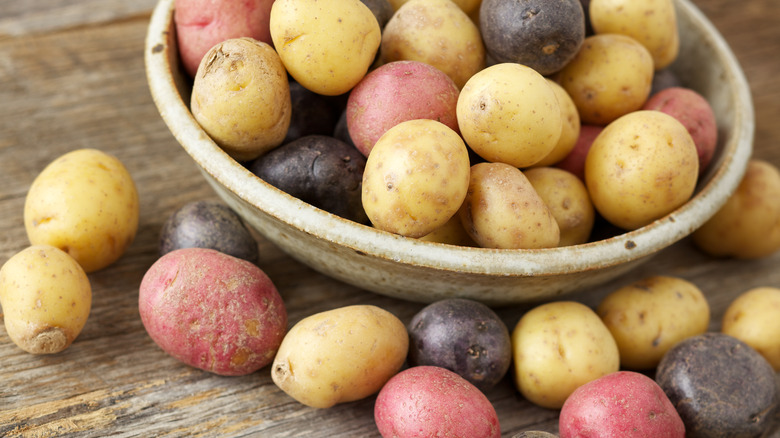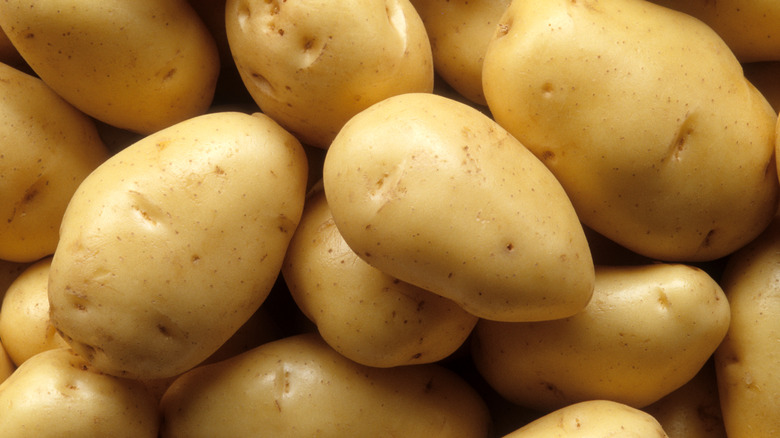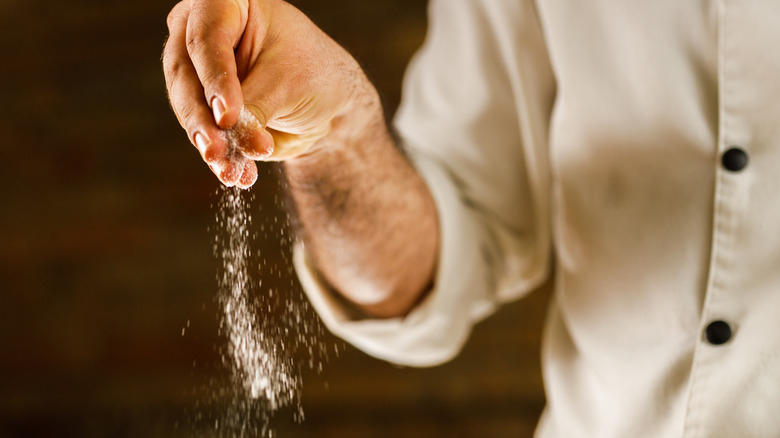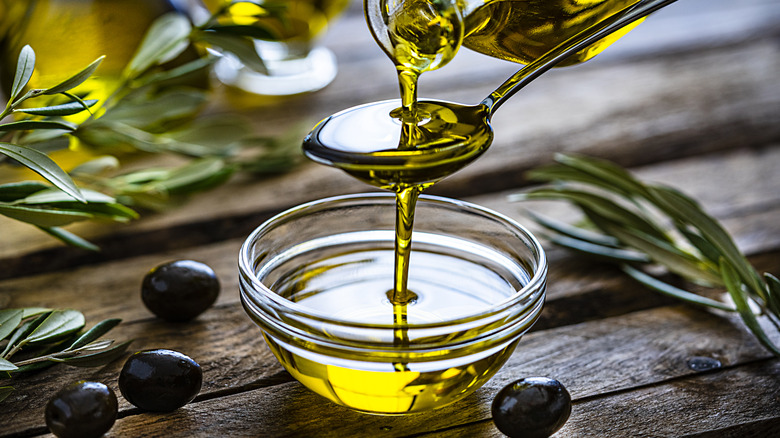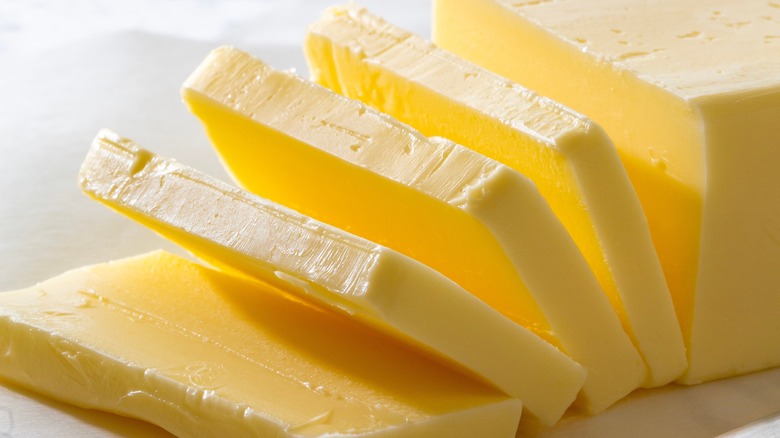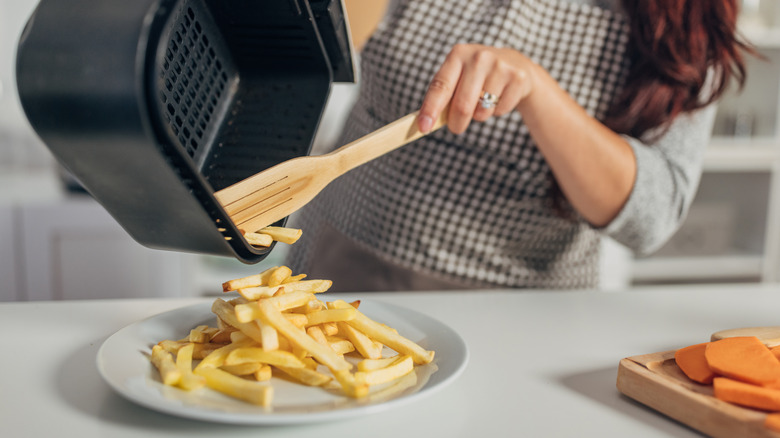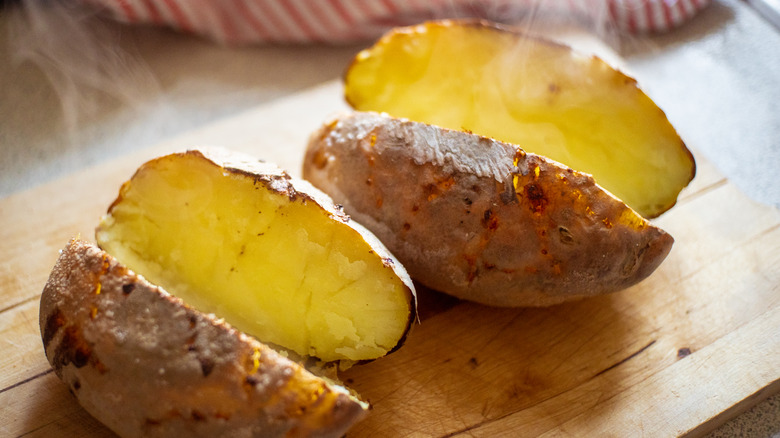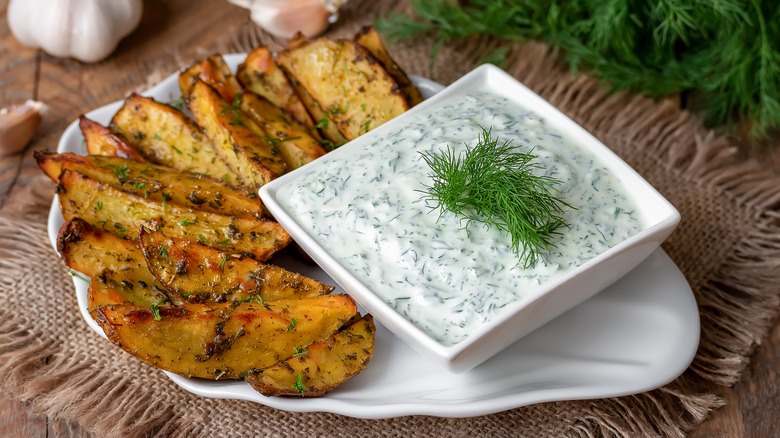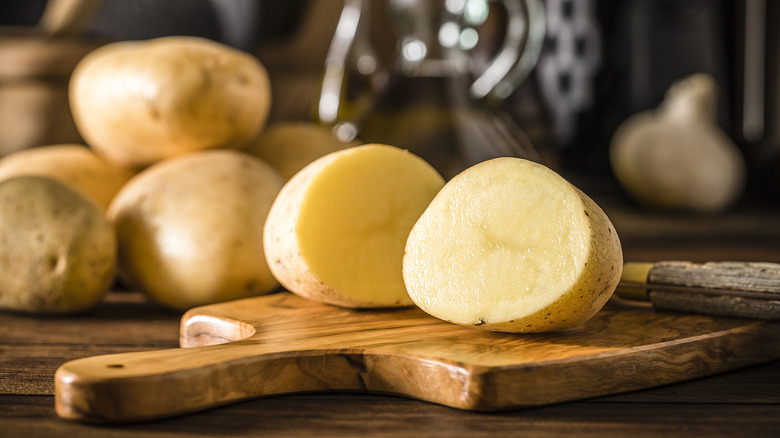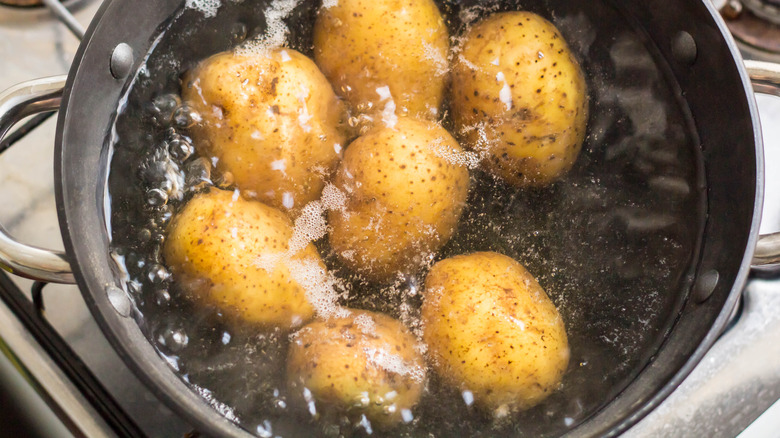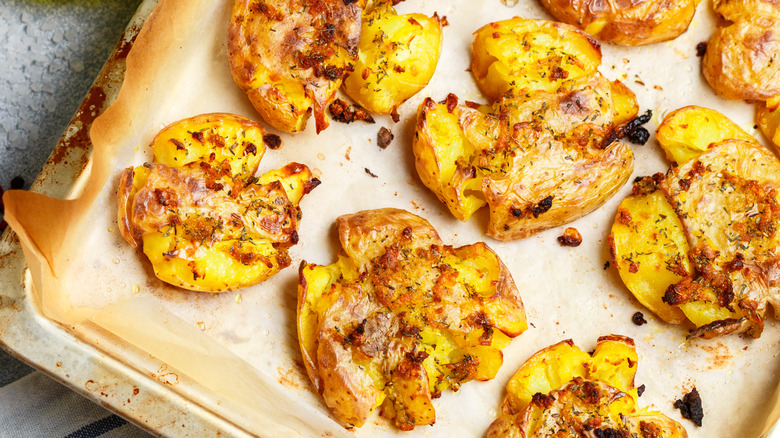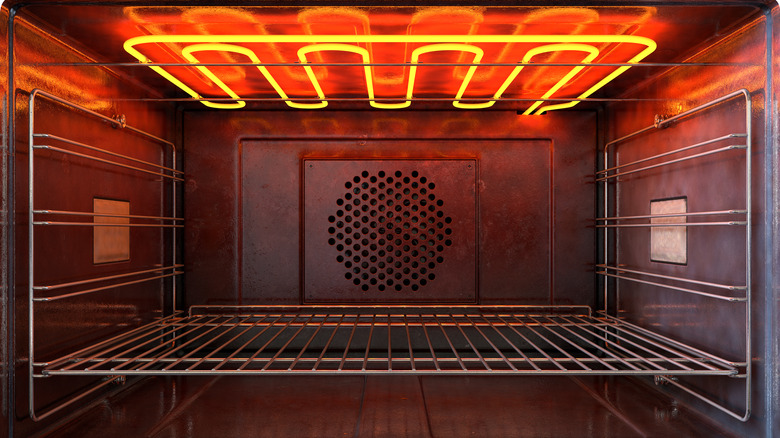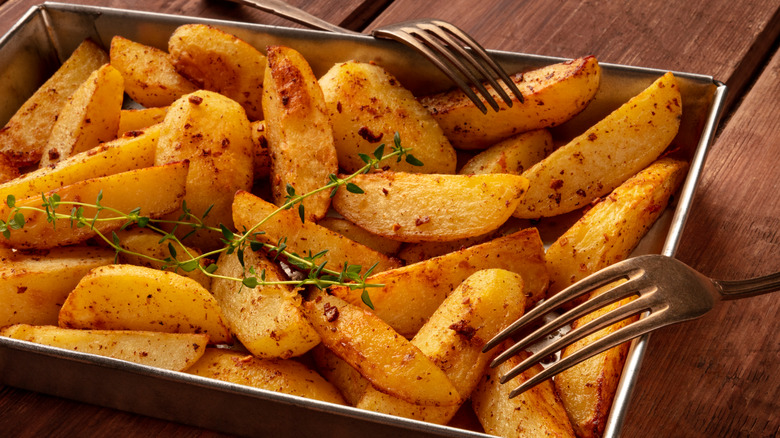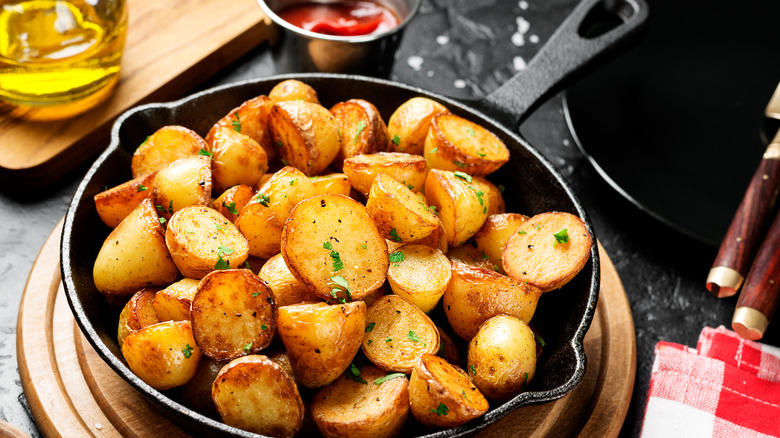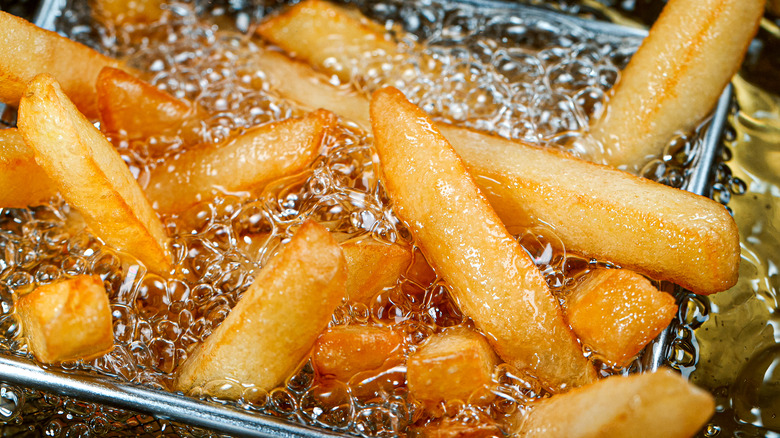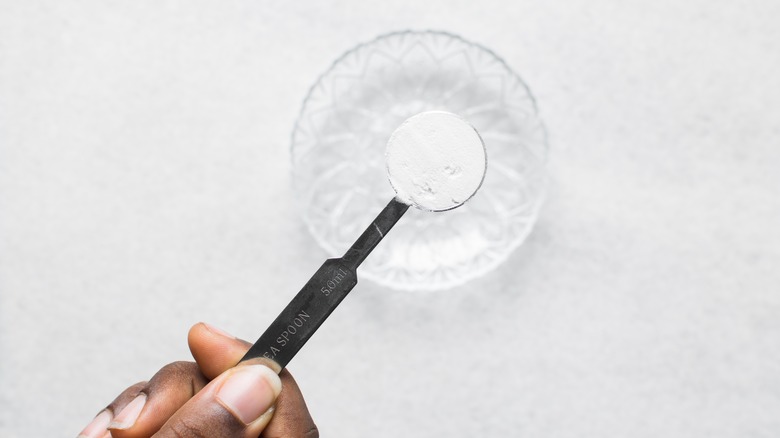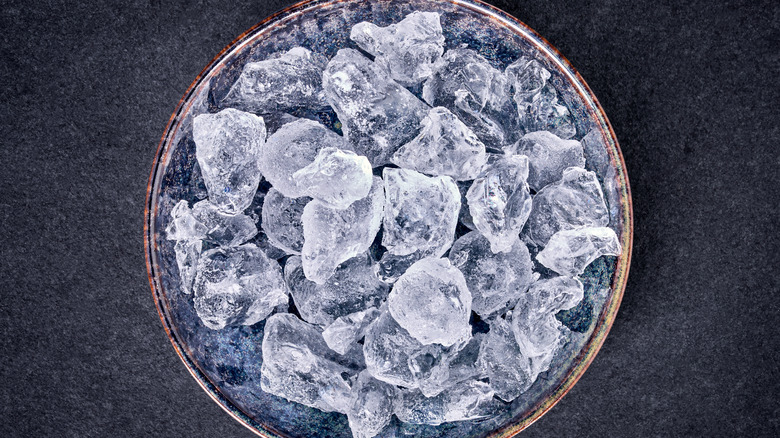17 Tips You Need For Deliciously Crispy Potatoes
Taters. Boil 'em, mash 'em, stick 'em in a stew, or make them into a delectable golden and crispy treat. The humble potato is a contributor to many a delicious dish, but perhaps one of its greatest qualities is its ability to offer the fluffiest pillowy inside whilst simultaneously satisfying the senses and the tastebuds with a bold, salty crunch.
The contrast between a light, soft interior, and a crispy exterior is something any potato can provide if treated with care by the cook, and there's the catch. Cooking the perfect crispy potato is a science and fortunately, it's something that can be learned. Whether you serve them up as the golden star of the show or you use them to compliment your next roast dinner, crispy potatoes are a crowd-pleaser and with these simple tips and tricks, you'll be serving up restaurant-quality crispy spuds from home in no time.
1. Choose the right potatoes
Every good food dish always starts with the right ingredients and a keen eye for ingredient selection, and a crispy potato dish is no different. Just as streaky bacon is better as a crispy breakfast staple than diced bacon, starchy potatoes crisp up better than other potato varieties. So, when selecting spuds specifically for their crispability, opt for starchy potatoes like Russets or Yukon Golds.
Yukon Gold potatoes in particular are known for their golden yellow coloring, buttery taste, and creamy texture — all qualities coveted by any crispy potato enthusiast. When paired with a crispy skin, the soft and fluffy texture of the flesh, and its rich, unique flavor make for a textbook crispy spud. Of course, the golden color of these taters only amplifies the beautiful tones you get from a perfectly cooked crispy potato.
2. Leave the skin on
The crisp factor of a potato all comes down to the skin. Whether you're making traditional roast potatoes or crispy smashed potatoes for dipping, it's the skin that makes the crunch. You wouldn't remove the skin of a turkey you plan on crisping up, so why peel your potatoes? If you've ever indulged in perfectly cooked crispy potatoes before, you'll know the skin is also packed with flavor and, arguably, what makes a crispy potato so scrumptious.
Leaving the skins on your potatoes has a handful of benefits. Not only does it assist the crisping process, but it also saves you the trouble of skinning your spuds (and cleaning up afterward), and it means you get extra protein, fiber, vitamins, and minerals.
3. Sprinkle them with salt
After choosing the ideal potato variety and leaving the vegetable peeler in the drawer, the next thing you need to do for restaurant-worthy crispy potatoes is washing, drying, and salting those spuds. Rinse them under cold water. If you have a vegetable brush, use it during this step to give them a scrub. Don't be shy to rough up the skin a little.
Next, pat your potatoes dry (a paper towel works great for this) and give them a generous sprinkle of kosher salt. Adding salt after washing and drying your spuds cleans and tenderizes them, adding an extra level of crispiness once cooked with oil. It also beautifully elevates the flavor of the potatoes. It's a must-do step if you're pursuing the ultimate crispy potato.
4. Drizzle your spuds with oil
Coating your potatoes evenly with oil before baking essentially faux-fries them, giving the skin that crispy restaurant quality while keeping the inside light and fluffy. When it comes to coating your spuds before cooking, you have a variety of fats to choose from including olive oil, canola oil, sunflower oil, and even melted butter for that extra buttery richness.
Crispy potatoes can only be achieved with a good coating of oil, so don't pursue the perfect crisp if you're trying to refrain from a higher fat content. You can always use a spray oil or a basting brush to give your taters a good coating without getting carried away, but ultimately, a crispy potato is a potato that was cooked with a healthy coating of oil.
5. Choose the best fat for your cooking method
Because you can make crispy potatoes with essentially any oil, it's best to have some discernment. Certain oils or fats work better with specific cooking methods, affecting the crisp and crunch of your taters. Using the wrong oil for your cooking method could mean a less-than-crispy outcome at best, and a charred mess at worst.
Olive oil works best for low-temperature roasting but it has a relatively low smoke point, making it unsuitable for high-temperature methods (which yield the best crunch) and causing a burnt skin in some instances. Animal fat like butter — or duck fat if you're feeling fancy — works better for methods like frying or high-temperature roasting. You could even try coating your spuds in mayonnaise, which gives all the benefits of coating in fat but with added flavor.
6. Choose oven roasting, air frying, or pan frying
Now that your potatoes are evenly coated in oil or fat, it's time to get cooking. For crispy potatoes, opt for cooking methods like oven roasting, air frying, or pan frying. Although it's ultra-convenient for home cooking, the microwave just doesn't have the same knack for making things crispy and golden that a traditional oven or air fryer does. If you're set on microwaving your taters, finish them on the grill or in the air fryer for the skin to crisp up.
Oven roasting or air frying yields the crispiest results if done at a high temperature. But if you're concerned about burning your potato skins and want to avoid making them thick and rubbery, parboil those spuds for an even cook throughout.
7. Release the steam
Steam is moisture, and cooking the perfect crispy potato is a balancing act when it comes to moisture levels. And when potatoes are about 80% water, it's no surprise they produce a lot of steam when heated. While you don't want a dry spud, too much moisture will undo all the work you've done from the preparation to cooking to try and get the perfect crisp. Fortunately, there are some hacks to strike the optimal moisture balance that gets you a light and fluffy inside and a crispy and golden exterior.
Let excess moisture escape during the cooking process by scoring your spuds or poking them with a fork before cooking. Promptly slicing your taters once they're out of the oven or air fryer is another way to preserve the crisp you've just achieved.
8. Select your sauce carefully
Potatoes always pair well with a sauce or dressing — think fries and ketchup, potato salad and mayonnaise, or even a classic roast potato with sour cream. Crispy spuds in particular pair great with a tasty dipping sauce. But the sauce you opt for could impact whether or not your taters get soggy.
The last thing you want after pouring so much love and intention into your crispy potatoes is for them to get soggy as soon as you add a condiment. If your goal is ultimate crispiness, be selective with what you choose. Crispy smashed potatoes or chunky potato bites work well for dipping, which helps to prevent any sogginess. But if you want to use your crispy spuds as a base for a potato salad, opt for less mayo or use a vinaigrette for a different take on the classic salad.
9. Consider chopping them up
Chopped crispy potatoes are the perfect rustic side or snack when paired with a dipping sauce like ketchup or sriracha mayo, but they're also a surefire way to get the ideal crisp. You can't rush a perfect crisp. But if time is a concern of yours and you're not up for hours of prep and cook time, cutting up your potatoes is the hack you need. Not only is it a timesaver, but if you cut your potatoes into the right-sized chunks, each bite has the perfect balance of fluffy innards and crispy outer shell.
Cutting your spuds up into pieces increases their surface area, which means more surface is available to get nicely crispy and golden in the cooking process. More surface area also equals more surface for seasoning to stick to, so if you want extra tasty, restaurant-quality crispy potatoes, chopping them up is a good idea.
10. Try parboiling them
Parboiling potatoes is the process of boiling them until they're partially cooked. When it comes to making crispy taters, you parboil just before your chosen cooking method like oven roasting or air frying. This ensures that the potatoes are nice and soft on the inside, and it gives you the option of high-temperature roasting without the risk of burning or overdoing the skin.
If you've ever had a roast potato with a thick, chewy skin, it probably spent a lot more time in the oven or air fryer than what's ideal. This extra step guarantees a perfectly cooked inside and helps prevent the skin from toughening up like that in the roasting stage. Because the appeal of crispy potatoes is actually down to the contrast between the soft inside and the crunchy outside, this trick can be a game changer.
Parboiling also presents another opportunity to inject some flavor into your dish. Salting the water while you parboil helps season your potatoes from the inside out.
11. Scratch or rough them up
A significant factor when it comes to making potatoes perfectly crispy is the potato skin or surface. For crispy taters, you want the surface to be as textured as possible. After parboiling, the exteriors of your spuds are nice and soft and it's time to get to work to get that crispy skin you're after. Pat your potatoes dry (try using paper towel) and shake them with your choice of fat until they're a little roughed up before roasting. You could also scratch your spuds up with a fork.
Either method damages the softened skin of the potato, increasing the surface area and creating the perfect conditions for fat to get into the potato and crisp up the skin even more. This is also why smashed potatoes crisp up so beautifully.
12. The hotter the better
Low heat is good at drying things out, which is great for homemade fruit chips or jerky, but it isn't what you want if you're in pursuit of the perfect crispy potato. If you cook your potatoes at a low heat (between 300 F and 325 F), you risk them becoming dry and chewy and they probably won't get that beautiful yellowy color you're after.
Instead, roast or air fry at a higher temperature (between 400 F and 450 F) to get that golden finish and the best crisp. If you parboil your potatoes before cooking, you can comfortably cook them at a high temperature without the risk of burning them because you reduce the amount of cooking time they need in the oven.
13. Ditch the baking pan
If you've opted for oven roasting or air frying, letting the potatoes cook directly on the rack gives them the best exposure to heat and air for the ideal distribution of crispiness and minimal risk of sogginess. When it comes to roasting potatoes, baking pans generally cause puddles of oil to gather at the base of the potato, resulting in a soggy texture you want to avoid and slowing down the roasting process.
It may feel wrong to pop your spuds directly on the oven rack, but it's a quick and easy hack you can use to give them the best chance of a crispy future. If you insist on using a baking pan, preheat it with the oven first for your best chance at even heat distribution from start to finish.
14. Leave the spuds alone
In order to get crispy, potato skin needs uninterrupted contact with heat. That means no turning, stirring, or prodding. Fiddling with your spuds too much could result in an uneven cook, so unless you're grilling potatoes on the barbecue, leaving them alone is the best thing you can do while they cook. The joy of making crispy potatoes is that once all the prep is done, you're free to do as you please, which makes them an ideal dish to serve to guests, or the ultimate Friday dinner you can set on the go while you relax.
If you're periodically opening the oven to disturb your taters, you're letting precious hot air escape. Even if you're frying your potatoes in a skillet, the more you leave them alone, the more chance they have to caramelize and crisp up nicely. If you're making crispy potato wedges in the oven, limit yourself to flipping them once halfway through the cooking time.
15. Preheat the fat
If you're parboiling then frying your potatoes, make sure your fat of choice is nice and hot before you add them to the pan. If the oil or fat is too cold, those nice soft parboiled taters will just soak up the cold oil resulting in soggy, greasy spuds.
You'll know your oil is at the right temperature if it's been on the stove for 5 to 10 minutes. You could also keep the popcorn handy while you fry and place a single kernel in the oil. When it pops, the oil is the perfect heat for frying. A thermometer works, too.
Remember, if you opt for frying, don't overcrowd the pan. If you arrange your spuds in a single layer in the pan, even if that means cooking in batches, they'll get an even, uniform crisp.
16. Use baking soda in your blanching water
Often, the key to crispiness is starch. Whether that's choosing starchy potatoes to roast or coating chicken in cornstarch for crispy chicken bites, starch makes the crunch and crip possible. When it comes to cooking the perfect crispy tater, blanching or parboiling helps ensure a good starchy surface, but this quick addition to your blanching water can make the results even better.
If you're parboiling, adding a ½ teaspoon of baking soda for every 2 cups of water makes it more alkaline which softens the potato exterior quickly and brings the potato's starch to the surface. The new starchy outside of the potato will hold oil even easier than before and crisp up to perfection thanks to all the texture created from this step.
17. Use ice water
Having a bowl of ice water while making crispy potatoes may sound a bit strange at first, but it's actually a tried and tested method of drawing out the starch from your spuds. Just as baking soda and blanching softens your potatoes and makes the surfaces extra soft and primed for crisping, soaking your potatoes or chopped-up potato pieces in ice water before roasting them helps draw the starch to the surface, creating the ideal surface for crisping up in the oven.
If you want to try using ice water for ultra-crispy roasted potatoes, simply put your potatoes or bite-sized potato chunks into a bowl of ice water and let them soak for a few minutes to a few hours. Then drain the bowl, pat those spuds dry with a paper towel and salt, and oil them for roasting.
